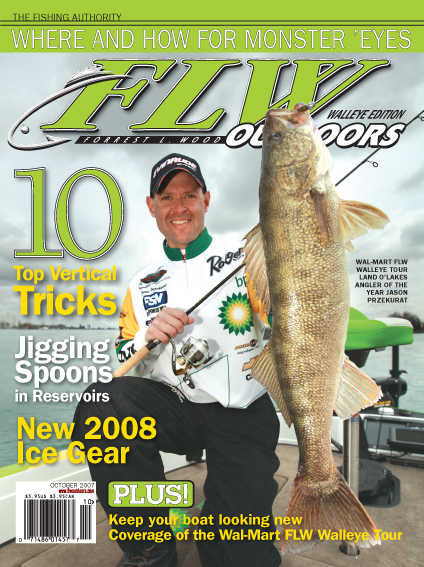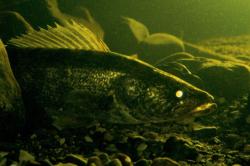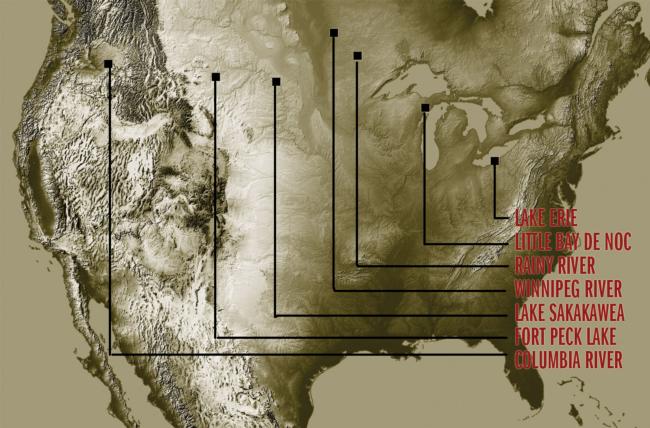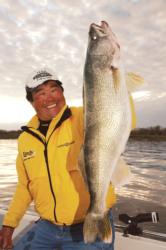Monster ’eyes
Where and how to catch trophy walleyes in the fall

Nothing makes the heart beat faster than the feel of a trophy walleye vibrating through a rod. But big-fish experiences don’t just happen, save for the occasional lucky encounter. A 10-pound walleye thrashing in the net is usually the result of good research and planning as much as it is fishing technique. Whether river, lake or reservoir, the key is to be on spots that host high concentrations of trophy fish at the times they are most apt to be there.
Wal-Mart FLW Walleye Tour pro Tom Backer of Fargo, N.D., who has caught several fish heavier than 12 and 13 pounds, believes autumn is best for big fish. His personal best of 14 1/4 pounds came from the Columbia River on the Washington-Oregon border one October week when he and his clients boated 8-pound fish one after another.
As the water temperature falls, big fish that roamed open water all summer in search of food begin to migrate toward structures they will use as spawning areas in spring. Their paths become predictable again. Walleyes also become more aggressive as baitfish numbers dip from their summer peaks, and colder weather and shorter days signal oncoming winter.
“Generally, fish will run bigger in fall,” Backer said. “Some fish you hardly see at any other time of the year will show up. If someone said, `You have a two-week window to fish to get the trophy of a lifetime,’ the first through the middle of October would be my first choice.”
Backer consults the stars to pinpoint the best trophy time. No, he doesn’t read his horoscope. He checks out moon phases. “The three days before the full moon are best,” he said.
Deciding where to fish is something else. Many places promise big fish, but fail to deliver. “I fished a lake in Minnesota for years,” Backer said. “The biggest fish I caught was 27 1/2 inches long and weighed 7 3/4 pounds. The first time I fished the Columbia River, my first fish weighed 13 3/4 pounds.”
 Big-fish spots generally have several traits in common, including a large number of naturally reproducing walleyes. There also must be ample quantities of the right kind of food. Backer prefers places that have forage high in fat and protein like ciscoes, smelt, shad or tullibees, which some call “cheeseburgers with fins.” The Winnipeg River is one of Backer’s favorite big-fish destinations because 29- to 30-inch walleyes can grow to 12 or 13 pounds on a menu of smelt and white bass.
Big-fish spots generally have several traits in common, including a large number of naturally reproducing walleyes. There also must be ample quantities of the right kind of food. Backer prefers places that have forage high in fat and protein like ciscoes, smelt, shad or tullibees, which some call “cheeseburgers with fins.” The Winnipeg River is one of Backer’s favorite big-fish destinations because 29- to 30-inch walleyes can grow to 12 or 13 pounds on a menu of smelt and white bass.
Backer also likes Fort Peck Reservoir in Montana. It is the fifth-largest man-made reservoir in the United States, and it is the site of the 16.63-pound state record walleye and the world record 15.66-pound saugeye.
There are as many ways to catch fall trophies as places to catch them. Here are a few destinations that showcase the variety of trophy tactics that can pay big dividends.
Rigging at Fort Peck and Lake Sakakawea
Fort Peck and Lake Sakakawea are both Missouri River reservoirs and are approached the same way. Backer starts with a map and seeks out places where the old river channel comes close to the shoreline. If gravel is present, it’s better yet.
“Where the river channel tucks in, that’s where they will be,” he said. “That’s where the smelt will be, and the walleyes will be nearby.”
Look for sharp drop-offs from structure at this time of year, where a 10-foot drop can occur within a boat length. Fish are often 20 feet deep, but don’t be afraid to go deeper, even 50 to 60 feet down. Lindy rigging is a good way to reach them.
“Bigger minnows are the key,” said Backer, who uses 4- to 6-inch creek chubs.
Use big No. 1 or 1/0 hooks to ensure better hooksets.
“People make the mistake of using No. 2 or No. 4 hooks with a big bait, and the hook doesn’t get into the mouth,” he said.
Hook the bait only through the top lip from inside the mouth. If you hook through both lips, the chub can’t breathe, and it dies. Lively chubs not only attract fish, but their frantic movements when danger approaches will alert an angler to get ready to set the hook.
Backer ties snelled hooks up to 6 feet long. The weight of his sinker depends on conditions. He uses a 3/8-ounce weight to fish 20 feet deep in calm weather. He may step up to a 3/4-ounce weight if the wind blows or if he has to go deeper.
Go slow. The water is cold, so make it easy for the fish. “I’ve seen people with three drift socks to go slowly enough,” Backer said.
Backer watches the screen for fish and will actually target individuals if the marks appear big enough to warrant extra effort. “Sit and hover right over it,” Backer said. “If the fish is there, the minnow shakes and vibrates through the rod.”
He feeds line when he feels a fish take the bait. How long depends on how aggressive fish are that day. Trial and error will tell, but if a fish grabs it, holds on and won’t commit, Backer likes to tease a strike by pulling gently back on the bait.
“OK, if you don’t want it, I’ll take it away,” he said. “Then suddenly – boom – she takes it.”
In the fall, walleyes often congregate at the mouths of rivers that empty into lakes. As a result, autumn can prove to be a trophy bonanza at places like the Winnipeg and Rainy rivers. Again, both can be fished in similar fashion, and peak time is October.
Spots that produce best are the relatively small, hard-bottom flats made of clay or covered with gravel that form in turns of the river channels as they run into adjacent bays. Use a map, a GPS and sonar to search for them. Isolated rocks on the channels also attract fish.
The more moving water, the better, according to Backer. Have two anchors onboard to anchor across the current to cover more depth ranges while you stay in place to ambush migrating fish. If you learn they are really tight to the break, anchor with the current from the bow. Change your boat position simply by moving the rope from the bow cleat to the port or starboard cleats.
The fish locations are often in 8 feet of water or less, so use 1/4- or 3/8-ounce Lindy Max Gap Jigs tipped with frozen shiners on the Winnipeg. Live bait, usually 2- to 3 1/2-inch shiners, works well on the Rainy. Keep frozen bait on the hook more effectively by pushing the hook through the mouth and out the gill before burying it in the fish. Bright colors and glow jigs are often most effective.
The Winnipeg River permits two hooks per line, so try using a StandOut hook about a foot up from the jig. The hooks must be barbless. The river holds walleyes up to 16 pounds, so use 10-pound-test line.
Only one hook per line is allowed on the Rainy, and it holds numbers of fish that weigh 10, 11 and 12 pounds, and 6-pound walleyes are common.
Action will be sporadic. You may get several fish one after another and then have a long dry spell. Move if things get too quiet for half an hour. Try anchoring or vertical jigging with the current farther upriver. A heavier 5/8- or 3/4-ounce jig will be necessary.
Slow-trolling can also pay big dividends on other rivers, like the Columbia. Backer has had tremendous fortune trolling deep-diving crankbaits like Bomber Deep Long As and Rapala Deep Down Husky Jerks on Stren Super Braid lines to reach monster walleyes cruising the Washington/Oregon border at 22 to 24 feet after dark.
The Great Lakes
FLW Walleye Tour pro Mark Brumbaugh of Arcanum, Ohio, also likes to fish his home waters of Lake Erie after dark in the fall to intercept big females moving from the Central Basin, where they spent the summer, to the Western Basin, where they spawn in spring. During warm weather, fishing deeper water during the day may be the trick.
Shore anglers on docks were able to take advantage of the fall gold rush up to a couple years ago when the lake level dipped. The winter of 2006 saw a return of some of that potential. But Brumbaugh likes to fish from a boat to get away from the crowds. He targets spots that have produced for him over the years from the Bass Islands eastward.
Lake Erie is dominated by fish that spawned in 2003 that are now 19 to 23 inches long.
“The bite is phenomenal,” Brumbaugh said. “We have limits in 40 minutes.”
But 10-pound-plus walleyes are fewer in number than in recent years. Fall is the time they become most vulnerable. At the same time, selective harvest is more important than ever. Take the younger fish that comprise 75 percent of the population, and leave the bigger fish so they can pass on their genes as long as they can. According to recent surveys, some of the bigger fish are more than 20 years old.
 October on the big lake can be rough with strong winds often blowing from the north. The peak time begins in November and continues into December. Last year’s relatively warm winter allowed anglers to fish open water until New Year’s.
October on the big lake can be rough with strong winds often blowing from the north. The peak time begins in November and continues into December. Last year’s relatively warm winter allowed anglers to fish open water until New Year’s.
Walleyes may be located over water 20 to 30 feet deep when it’s warm or during the day, or 15 feet when it’s colder or dark. Either way, they are usually found chasing baitfish in the top 10 feet of the water column.
Brumbaugh targets the fish with two principle baits. He runs Reef Runners 15 to 20 feet behind the boards and Reef Runner Ripsticks 20 to 30 feet back. Year in and year out, it’s hard to beat blue and chrome, but other colors – mostly natural ones and white – work too.
The best trolling speed is 1.2 to 2 mph, and the best location is where baitfish are present on the sonar screen. Cruise until you see the schools. There’s no need to fish where other boats are fishing.
“I just drive around until I see fish,” Brumbaugh said. “Last year, I fished for a whole week and never saw another boat, and it was nonstop catching.”
For night-fishing, Brumbaugh tapes glow sticks to the flags of his planer boards, or he drills a small hole and inserts a bobber light from a Thill Nite Brite Lighted Float, which can be switched off when not in use.
Brumbaugh uses 10-pound-test monofilament, but elsewhere on the Great Lakes, anglers, like FLW Walleye Tour pro John Balla of Bartlett, Ill., use lead core to reach fish that are sometimes 50 feet or more down at places like Little Bay de Noc on Lake Michigan.
Balla targets breaklines on reefs on the west side of the bay all the way to the Cedar River and the Cedar River humps. He and his partner, Kevin Byrne, caught two double-headers on one trip. One double consisted of 26- and 28-inch fish. The other produced a 27- and 28-incher. He targets depths 40 to 60 feet down over 50 to 80 feet of water.
After adding backing to your reel, splice in three colors of lead core, or 30 yards on most rods. Put five colors on one rod to run deeper, and add a 30-foot leader of 12-pound monofilament and a good, quality crankbait snap to each rod.
Balla likes floating black crankbaits with orange bellies, blues, metallic and rattling crankbaits. Troll at a crawl, just 0.8 to 1.2 mph.
GPS with a mapping program helps by tracing trolling passes, marking spots and keeping boats near breaklines.
Take caution when fishing extremely cold water. Check weather reports, and if storms or winds are on the way, stay home. Make sure all your equipment is working, including bilge pumps, marine radio and cell phones. Let someone on shore know where you are going and what time you plan to return.
Don’t put your boat away too soon this year. The best time to up your heart rate with a 10-pounder on the line may be when the open-water season is coming to a close.
